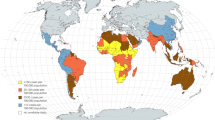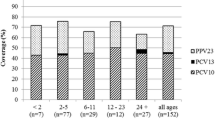Abstract
Bacterial meningitis is an important cause of morbidity and mortality in the United States and throughout the world. Over the past 20 years, there have been significant changes in the epidemiology of bacterial meningitis. The most important change is the decrease in the frequency of Haemophilus influenzae type b as the most common etiologic agent of bacterial meningitis, since the H. influenzae type b conjugate vaccine was introduced. Streptococcccus pneumoniae is now the major cause of bacterial meningitis in the US and bacterial meningitis is now a disease predominantly of adults, rather than of infants and children. Emergence of antimicrobial resistance in S. pneumoniae has also altered the approach to antimicrobial therapy in patients with pneumococcal meningitis, indicating the need to use preventive strategies to reduce the frequency of this serious infection. Recent licensure of the heptavalent pneumococcal conjugate vaccine will likely decrease the overall incidence of pneumococcal meningitis.
Similar content being viewed by others
References and Recommended Reading
Carpenter RR, Petersdorf RG: The clinical spectrum of bacterial meningitis. Am J Med 1962, 33:262–275.
Fraser DW, Henke CE, Feldman RA: Changing patterns of bacterial meningitis in Olmsted County, Minnesota, 1935–1970. J Infect Dis 1973, 128:300–307.
Fraser DW, Geil CC, Feldman RA: Bacterial meningitis in Bernalillo County, New Mexico: a comparison with three other American populations. Am J Epidemiol 1974, 100:29–34.
Schlech WF III, Ward JI, Band JD, et al.: Bacterial meningitis in the United States, 1978 through 1981. The national bacterial meningitis surveillance study. JAMA 1985, 253:1749–1754.
Wenger JD, Hightower AW, Facklam RR: the Bacterial Meningitis Study Group: Bacterial meningitis in the United States, 1986: report of a multistate surveillance study. J Infect Dis 1990, 162:1316–1323.
Adams WG, Deaver KA, Cochi SL, et al.: Haemophilus influenzae Study Group: Decline of childhood Haemophilus influenzae type b disease in the Hib vaccine era. JAMA 1993, 269:221–226.
Ahmad H, Chapnick EK: Conjugate polysaccharide vaccines. Infect Dis Clin North Am 1999, 13:113–133. This article discusses conjugate polysaccharide vaccines for Haemophilus influenzae, Streptococcus pneumoniae, and Neisseria meningitidis; availability of these vaccines may reduce the incidence of diseases caused by these microorganisms.
Centers for Disease Control and Prevention: FDA approval of use of Haemophilus b conjugate vaccine for infants. MMWR 1990, 339:698.
American Academy of Pediatrics, Committee on Infectious Diseases: Recommended childhood immunization schedule — United States, January–December 2000. Pediatrics 2000, 105:148–151.
Robbins JB, Schneerson R, Anderson P, Smith DH: Prevention of systemic infections, especially meningitis, caused by Haemophilus influenzae type b. JAMA 1996, 276:1181–1185.
Van Alphen L, Spanjaard L, Van der Ende A, et al.: Effect of nationwide vaccination of 3-month-old infants in The Netherlands with conjugate Haemophilus influenzae type b vaccine: high efficacy and lack of herd immunity. J Pediatr 1997, 131:869–873.
Mulholland K, Hilton S, Adegbola R, et al.: Randomised trial of Haemophilus influenzae type-b tetanus protein conjugate for prevention of pneumonia and meningitis in Gambian infants. Lancet 1997, 349:1191–1197.
Schuchat A, Robinson K, Wenger JD, et al.: Bacterial meningitis in the United States in 1995. N Engl J Med 1997, 337:970–976. This laboratory-based surveillance study of cases of bacterial meningitis in the United States 5 years after licensure of the Haemophilus influenzae type b conjugate vaccine shows that Streptococcus pneumoniae is now the most common etiologic agent of bacterial meningitis in the United States.
Campbell GD, Silberman R: Drug-resistant Streptococcus pneumoniae. Clin Infect Dis 1998, 26:1188–1195. This is a recent review of the mechanisms, risk factors, and approach to management in patients with antimicrobial-resistant S. pneumoniae infections.
Song JH, Lee NY, Ichiyama S, et al.: Spread of drug-resistant Streptococcus pneumoniae in Asian countries: Asian network for surveillance of resistant pathogens (ANSORP) study. Clin Infect Dis 1999, 28:1206–1211.
Ko AI, Reis JN, Coppola SJ, et al.: Clonally related penicillinnonsusceptible Streptococcus pneumoniae serotype 14 from cases of meningitis in Salvador, Brazil. Clin Infect Dis 2000, 30:78–86.
Fung CP, Hu BS, Lee SC, et al.: Antimicrobial resistance of Streptococcus pneumoniae isolated in Taiwan: an islandwide surveillance study between 1996 and 1997. J Antimicrob Chemother 2000, 45:49–55.
Hofmann J, Cetron MS, Farley MM, et al.: The prevalence of drug-resistant Streptococcus pneumoniae in Atlanta. N Engl J Med 1995, 333:481–485. This epidemiologic study of the prevalence of antimicrobial-resistant Streptococcus pneumoniae in Atlanta indicates that 25% of pneumococcal isolates are resistant to penicillin.
Klugman KP, Madhi SA: Emergence of drug resistance. Impact on bacterial meningitis. Infect Dis Clin North Am 1999, 13:637–646.
Tunkel AR, Scheld WM: Acute meningitis. In Principles and Practice of Infectious Diseases edn 5. Edited by Mandell GL, Bennett JE, Dolin R. Philadelphia: Churchill-Livingstone; 1999:959–997. This chapter provides a recent discussion of the epidemiology, clinical presentation, diagnosis, and management of acute bacterial meningitis. It reviews specific recommendations for the approach to patients with antimicrobial-resistant meningeal pathogens.
Centers for Disease Control and Prevention: Prevention of pneumococcal disease: recommendations of the Advisory Committee on Immunization Practices (ACIP). MMWR 1997, 46(RR-8):1–23.
Rennels MB, Edwards KM, Keyserling HL, et al.: Safety and immunogenicity of heptavalent vaccine conjugated to CRM197 in United States infants. Pediatrics 1998, 101:604–611.
Black S, Shinefield H, Fireman B, et al.:Efficacy, safety and immunogenicity of heptavalent pneumococcal conjugate vaccine in children. Pediatr Infect Dis J 2000, 19:187–195. These authors report the trial of the efficacy of the heptavalent pneumococcal conjugate vaccine, which demonstrates an efficacy of 97.4% in the prevention of invasive pneumococcal infections caused by the 7 serotypes of pneumococcus in the vaccine.
US Department of Health and Human Services: First pneumococcal vaccine approved for infants and toddlers. HHS News; February 17, 2000.
Lieu TA, Ray GT, Black SB, et al.: Projected cost-effectiveness of pneumococcal conjugate vaccination of healthy infants and young children. JAMA 2000, 283:1460–1468. These authors project the efficacy and cost-effectiveness of the heptavalent pneumococcal conjugate vaccine in a hypothetical cohort of 3.8 million infants in the United States.
Author information
Authors and Affiliations
Rights and permissions
About this article
Cite this article
Short, W.R., Tunkel, A.R. Changing epidemiology of bacterial meningitis in the United States. Curr Infect Dis Rep 2, 327–331 (2000). https://doi.org/10.1007/s11908-000-0011-2
Issue Date:
DOI: https://doi.org/10.1007/s11908-000-0011-2




